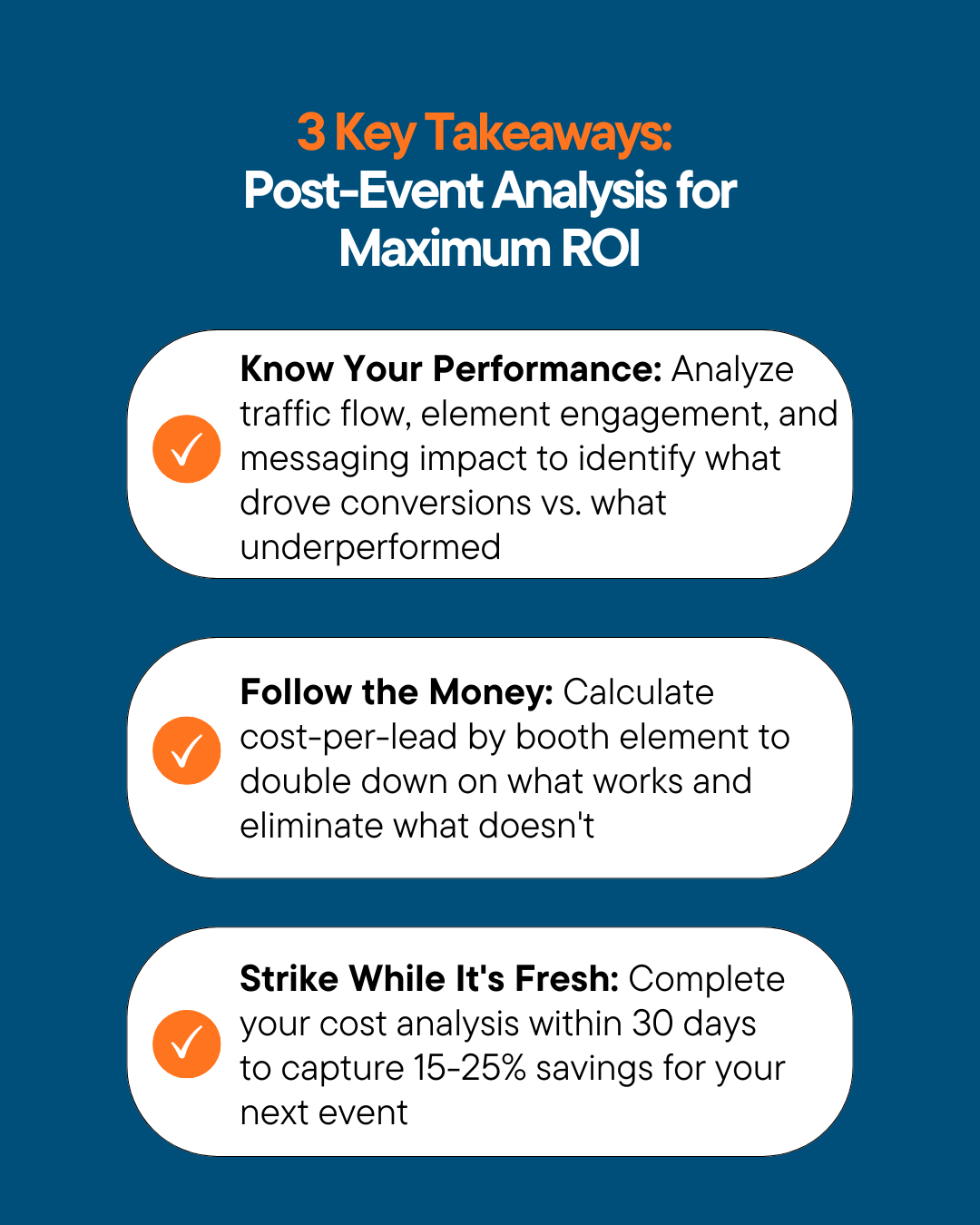Post-Show Performance Assessment: Maximizing the Value of Your Exhibit Assets After the Event
When the carpet is rolled up and the crates are outbound, many exhibitors call the show a wrap. But the truth is, the most strategic and profitable teams know the real ROI begins after the event. Post-show booth assessment is when performance gets evaluated, costs are analyzed, and strategic improvements are identified to deliver better results at your next exhibition.
Post-Show Performance Assessment: Maximizing the Value of Your Exhibit Assets After the Event
When the carpet is rolled up and the crates are outbound, many exhibitors call the show a wrap. But the truth is, the most strategic and profitable teams know the real ROI begins after the event. Post-show booth assessment is when performance gets evaluated, costs are analyzed, and strategic improvements are identified to deliver better results at your next exhibition.
In fact, trade shows remain one of the most powerful channels in the B2B toolkit, with 31.6% of marketing budgets dedicated to shows and smart brands seeing average returns of 4:1 when managed well. That's why your post-show performance review is not an afterthought it's the strategy that ensures your next event performs even better.
Why Post-Show Booth Assessment Matters
· The investment is significant. A new exhibit can cost $55–$300 per square foot, not including travel, services, and labor.
· Performance data drives decisions. Systematic booth evaluation identifies what worked, what didn't, and where to invest next.
· ROI optimization requires analysis. Without structured post-show assessment, much of that spend potential is left unrealized.
ROI Insight: Exhibitors who conduct thorough post-show booth performance reviews consistently outperform those who skip this critical analysis phase.
Step 1: Conduct Immediate Traffic Flow Assessment
Your booth's visitor patterns tell the complete story. Don't let those insights disappear.
· Map visitor entry and exit points to identify natural traffic flow
· Document congestion bottlenecks and dead zones
· Measure dwell time at key booth elements and displays
· Track which areas generated the most qualified conversations
Pro Tip: Traffic flow data becomes your blueprint for optimizing booth layout and maximizing visitor engagement at future events.
Step 2: Analyze Booth Element Performance
Every component of your exhibit served a purpose, now measure how well each performed.
· Evaluate activation effectiveness. Which demonstrations and interactive elements drew crowds versus those that were ignored?
· Assess technology performance. Review digital displays, lead capture systems, and interactive tools for user engagement and technical reliability.
· Review messaging impact. Analyze which call-to-actions drove meeting bookings and which messaging resonated with your target audience.
· Document visual effectiveness. Evaluate graphics visibility, lighting impact, and overall brand presence from various show floor distances.
· Analyze staff positioning. Identify optimal staffing zones and peak engagement periods for better resource allocation.
ROI Insight: Performance data by booth element helps you double down on high-converting components while eliminating or improving underperforming assets.
Step 3: Evaluate Lead Generation and Conversion Metrics
Speed and quality matter but so does understanding what drove results.
Your assessment checklist:
· Calculate cost per lead by booth zone and activity type
· Analyze lead quality scores by engagement method (demo, literature, conversation)
· Review response time impact on conversion rates
· Measure follow-up effectiveness and meeting booking rates
Pro Tip: Understanding which booth elements generated your highest-quality leads helps optimize your investment for maximum ROI at future shows.
Step 4: Conduct Comprehensive Cost Analysis
Think of your booth budget like a business unit. Post-show financial review reveals optimization opportunities:
· Operational costs: Identify unexpected expenses like drayage overages, labor inefficiencies, or service add-ons
· Asset utilization: Calculate return on investment for technology, displays, and promotional materials
· Logistics efficiency: Review shipping, storage, and setup costs for consolidation opportunities
ROI Insight: Detailed cost analysis often reveals 15-25% savings opportunities through logistics optimization and smarter asset management.
Step 5: Create Data-Driven Improvement Strategy
Your next booth design should be driven by performance evidence, not assumptions.
· Traffic flow insights → optimize entry points, signage placement, and demonstration areas
· Engagement data → invest in proven activation types and eliminate underperformers
· Cost analysis → implement lightweight, modular solutions that reduce shipping and labor expenses
· Lead quality metrics → refine targeting and messaging for better prospect qualification
Pro Tip: Use your post-show assessment to create a strategic brief ensuring your next booth is performance-optimized, not just visually updated.
30/60/90-Day Post-Show Assessment Timeline
· Days 0–7: Complete immediate traffic flow and engagement analysis, document team observations, and begin lead response protocols.
· Days 8–30: Analyze comprehensive performance data, identify quick-win improvements, and repurpose successful content assets.
· Days 31–90: Develop strategic optimization plan, budget for proven improvements, and update exhibit strategy based on performance insights.
Why Post-Show Assessment Is Critical for ROI
If your booth struggled with poor traffic flow, unclear messaging, inefficient logistics, or underperforming technology, the weeks after the show are the optimal time to diagnose and fix these issues.
Strategic improvements based on performance data, like optimized layouts, proven messaging, or efficient logistics, often pay for themselves through improved lead generation and reduced operational costs at your next event.
ROI Insight: Post-show performance assessment is the most cost-effective way to improve trade show ROI before bad patterns become expensive habits.
Post-Show Assessment Is Where Exhibition ROI Is Optimized
Trade shows remain one of the most powerful B2B marketing channels, but only when performance is systematically measured and improved. By combining thorough traffic analysis, booth element assessment, cost evaluation, and data-driven optimization, you transform each event into valuable intelligence for better future performance.
Want to ensure your next show delivers measurable improvements? A Post-Show Performance Assessment Workshop can help you analyze what worked, identify optimization opportunities, and develop strategic upgrades that enhance ROI.
Ready to maximize your exhibit ROI? Let’s regroup and optimize before your next event.

